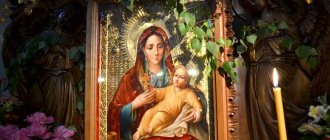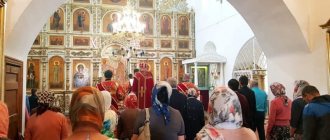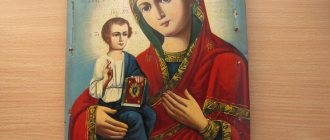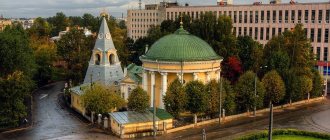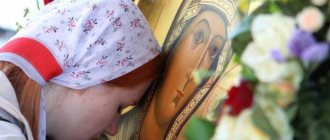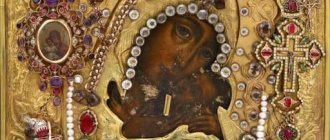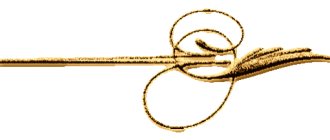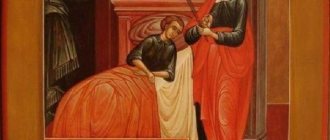Icon of the Mother of God of Perpetual Help
The same thing happened with the icon of the Virgin Mary Kardiotissa. It was painted in the 9th century by the brilliant icon painter Lazarus of Constantinople. The Monk Lazarus was engaged in icon painting for the glory of God, the Most Pure Virgin Mary and the Saints.
During the period of iconoclasm, everything connected with the Christian faith was mercilessly destroyed. The creators of icons were also persecuted. Cruel torture was applied to the hieromonk and draftsman Lazar. But he did not lose his faith even after repeated torture, and continued to paint the faces of the Saints.
The euphonious name of the temple Kera Kardiotissa is translated from Greek as Lady Mother of God of the Heart: the Mother of God is depicted sitting with the Baby Jesus on her knees, supporting him with her left (that is, from the side of the heart) hand. “Heart” translated from Greek “kardiá”.
The icon was stolen by the Turks twice: the first time on the orders of the Byzantine Emperor Theophilos. But the icon was returned and chained to a marble column. Then she was kidnapped a second time, along with whatever she was chained to. And again the icon was returned.
The third time was significant for the icon - it was stolen by a wine merchant from Rome in 1498 to bring it to his city. On the way, he fell ill and was forced to stay in someone else's house. Anticipating his imminent death, he confessed to the crime to the owners and asked that the relic be preserved and given to the church.
The Mother of God often appeared to the women living in that house, and every time on time. So she was called “Our Lady of Perpetual Help.” Only a year after the death of the merchant-thief, the icon was transferred to the Church of St. Matthew, and this name stuck with it. Later it was transported to the monastery of St. Eusebius, then to the Church of the Virgin Mary in Pasteurul, and today it is kept in the Church of St. Alphonsus in Rome.
The same pillar and chain with which the icon of the Mother of God of Perpetual Help was chained are kept in the courtyard of the monastery. And every visitor has the right to touch the shrines, pray and receive help from the Higher Powers.
Church of Panagia Kera
The Kera Church is also known for its numerous frescoes, which have been relatively well preserved here since the time of the Byzantine Empire: the painting in the oldest part of the church dates back to the very beginning of the 14th century, and the remaining frescoes date back to the second half and end of the 14th century. To protect the frescoes from vandalism during the Turkish occupation, local residents covered them with a thick layer of lime, thereby hiding the decoration of the church and its ancient origins.
In addition to its purely religious function, the monastery also participated in the resistance movement and helped the Greeks who rebelled against the Ottoman Empire. The monastery was attacked by the Turks twice - in 1822 and 1842, but was restored each time. Later, in 1866, during the famous Cretan Uprising, it was one of the main centers of resistance.
By the way, keep in mind that taking photographs of the icon in the church is officially prohibited, although some tourists neglect this, but you can take pictures on the territory without any restrictions. Kera Kardiotissa Monastery on video:
The island of Crete, like all of Greece, is full of myths, legends and various stories. Believe in legends or adhere to official science? Decide for yourself, but you can plan a visit to this place during your travels around the island in any case.
Kera is a monastery lost in the mountains with a special atmosphere and history.
Among other things, this is just a very pleasant and beautiful place where you can not only see an old church, go to a museum and get acquainted with history and religion, but also enjoy magnificent views, wildlife, silence, after all, if you get here without a tour Kera Monastery on Crete, view at the entrance to the territory:
Kera Monastery on Crete, view at the entrance to the territory:
The entire monastery and church can be explored in literally 25-30 minutes; you will even have time to look at the church shop with icons, candles, honey and olive oil, that is, this is not at all an attraction that you need to set aside a whole day for. However, it can be successfully included in your route around the island, for example, combined with a trip to the Lassithi Plateau and the Cave of Zeus (Οροπεδιο Λασιτιου, Lassithi Plateau).
Please note that the monastery has visiting hours, and entrance to the territory is paid - a ticket costs 2 euros for adults, free for children. Candles in the church can also be taken for free, but if you wish, you can leave a small donation - there is a special “chest” for this.
The monastery opens early in the morning, but in the middle of the day it is closed to all categories of guests, and from 13:00 to 15:30 you cannot enter it. Advice for independent travelers: it is best to come to the monastery either early in the morning or late in the evening, when there are a minimum of excursion groups there.
Regardless of the season, try not to forget about appropriate clothing: in Orthodox churches, men are required to remove their headdress when entering the church building, and women are required to have a headscarf and a long skirt with them (at least their knees must be covered). Of course, there are no extremely categorical hard and fast rules here, and no one will drive you away, but in general it is better to adhere to a simple principle: clothing should be modest, no micro-shorts, short T-shirts or hats.
Icon of the Mother of God of the Heart
The icon of Panagia Cardiotissa in the Cretan monastery is a copy painted by an unknown artist in 1795. The Mother of God in a dark red robe and a dark blue chiton sits on a throne. She holds the Divine Child in front of her, and next to her and the Divine Child are the Prophets David, Solomon, Isaiah and Habakkuk.
Despite the fact that the author remains unknown to history, this icon, like the “first” one of Lazarus, has miraculous and healing properties. People come to the monastery for her sake, to touch and pray. It is noted that the most fervent requests and prayers bring tears to the Mother of God.
The last unsuccessful attempt to steal the icon occurred in 1892. The thieves stole something, but for some reason abandoned it along the way. The relic was immediately taken back to the monastery as part of a group of believers.
- Normal fetal heart rate in the womb: table of heart rate indicators by week
How to get to the monastery of Kera Kardiotissa
The Monastery of the Virgin Mary is located in the north-eastern part of the island of Crete near the villages of Ano Kera (Ανω Κερα, Ano Kera) and Kato Kera (Κατω Κερα, Kato Kera), and can be very easily reached by car. If you live on the northern coast, then head towards the city of Malia, where the road deep into the island begins. Follow the signs for the Lasithi plateau - the monastery is just on the way to the plateau and the Cave of Zeus, both very famous places, and there will be a lot of signs on the roads both in the direction from the east and from the west.
We reached Malia - we turn south from the federal highway. After exiting onto this road, you only have to drive about 11-13 kilometers. The roads here are not wide, not fast, but quite good, and the rest of the route along rather beautiful small serpentines will allow you to get to the monastery in 20-25 minutes with stops at observation platforms. The simplest thing is to click on the church icon on the map, select “Get here”, and enter where you are going to leave from - the route will be built automatically. Monastery of Kera Kardiotissa on the map of Crete:
Show options Hide options Additional settings
All attractions on one map »»»
Monastery of Kera Kardiotissa, GPS coordinates: 35.22458, 25.46148
The monastery is located a little away from the main road, and it has its own small parking lot - there’s definitely room for a car! Keep in mind that you cannot get here by regular bus, and a taxi ride can be quite expensive. Therefore, either get there in a rented car yourself, or consider options with ready-made excursions or personal guides.
By the way, for lovers of hiking there will be not only an interesting route, but also a corresponding legend: nearby there is a gorge and a path along which, according to legend, the Virgin Mary herself walked. On the way, she stopped to rest, leaned against a rock and... her palm print remained in the rock! But this is a topic for a separate article 
History of the icon
The history of the icon is closely connected with the convent of Kera Kardiotissa - Mother of God of the Heart. It is located in a picturesque location, surrounded by mountains at an altitude of 622 meters. Inside the monastery there is a Byzantine church, the main shrine of which is the icon of the Virgin Mary Cardiotissa. The icon is famous for healing the suffering, as well as for its legendary history and numerous adventures.
The monastery was built in the 13th century during the Byzantine period. The name of the monastery was given by the icon of the Mother of God Cardiotissa, which was painted, according to legend, in the 8th century by the monk-icon painter Saint Lazarus. Since ancient times, the icon was considered miraculous: it healed the sick and infirm, and especially helped women who did not have children.
Three times the miraculous icon was stolen by the Turks and taken to Constantinople, but it invariably returned. They even made an attempt to chain the icon to a marble column, but this also did not yield results. The icon of the Mother of God Cardiotissa has returned again, as they say, along with a chain and even a column. And indeed, there is a column in the monastery courtyard, and on the iconostasis next to the image there is a chain. Truly a miraculous icon! In 1498, the icon of Kerr Cardiotissa was stolen by a wine merchant and taken to Italy. And the icon that is in the monastery to this day is a copy painted in 1735.
However, it is also considered miraculous, apparently the place here is special - holy.
However, the sanctity of the place did not prevent military action: after the fall of the Byzantine Empire and the capture of Crete by the Turks, the territory of the Kera Kardiotissa monastery served as a refuge and shelter for the rebels. And during the 2nd World War, the German command equipped a prison in the monastery.
Today the monastery of Kera Kardiotissa is a quiet and peaceful place. It can shelter 25 people from worldly temptations, but today only a few nuns and abbess live there. On the territory of the monastery there is a museum, which displays church utensils and books.
And once again the icon was stolen in May 1982 by antiquities smugglers. But they simply abandoned her, it is believed that under the force of her extraordinary influence. She was taken to the Church of St. Mina in Heraklion, from where the believers carried her in their arms for 50 km to place her in her former place, in the monastery church.
Now it is located in the Catholic (cathedral, universal) church of the monastery, under it is the inscription Mother of God and Lady Cardiotissa (Kera Cardiotissa), which is the name today of the nunnery, which is located at the entrance of the Lasithi plateau on the island of Crete. The icon was painted in 1795 by an unknown artist on a copper sheet.
Monastery of Our Lady of Crete
It is not known for certain when exactly the Kera monastery was founded, and to our time only approximate information has been preserved. It is believed that Panagia Kera (Παναγια Κερα, Panagia Kera) was built in the Byzantine period, and the foundation dates are usually indicated between approximately 961 and 1204, since the monastery is mentioned in the scriptures already in 1333.
Stavropegia (σταυροπηγια, literally “installation of the cross”) is a special status that makes monasteries independent of local diocesan authorities. The cross in these monasteries is erected by the patriarchs themselves, after which the monastery is directly subordinate to the patriarch or synod.
Now it is a working monastery, on the territory of which there is a Byzantine church and several buildings around a small courtyard with well-kept fruit trees. The way the church looks today is actually the result of several stages of construction, destruction, restoration and reconstruction.
Initially, only a church with one nave and a pointed vault without supporting arches was erected in this place. Later, after expansion, this part of the church became its altar, and two vestibules were completed on the western side. Lastly, a small chapel was added, and the church acquired the appearance that has survived to this day.
Excursion to the monastery of Kera Kardiotissa
If you are a religious person and you are interested in the topic of the monasteries of Crete, then a visit to Kera Kardiotissa should definitely be included in it. If religion is not the main purpose of your visit to the island, then you can stop by the monastery on the way to other attractions - the place truly fascinates with its tranquility and beauty, especially in the evenings. Interesting? We will be happy to offer you:
- Excursion to the Palace of Knossos, the monastery of Kera Kardiotissa, the Lassithi plateau and the cave of Zeus
- Private excursion “Monasteries of Crete” - by car with an individual driver-guide
Have a nice trip!

